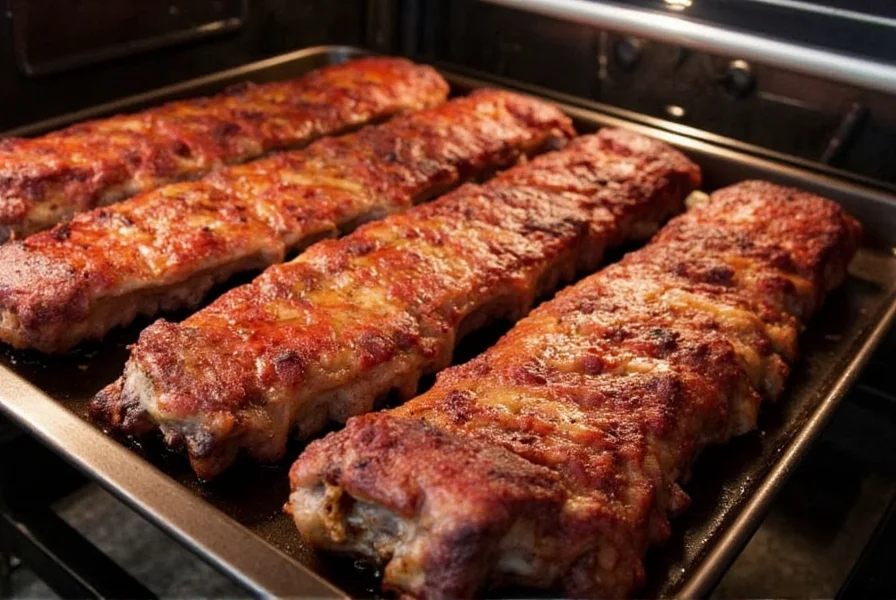Why Slow Baking Ribs in Oven Works Best
Slow baking transforms tough connective tissues in ribs into gelatin through controlled, low-temperature cooking. Unlike grilling, oven baking provides consistent heat distribution without flare-ups that cause uneven cooking. This method eliminates the need for constant monitoring while delivering restaurant-quality results. Professional pitmasters use this technique when outdoor conditions prevent traditional smoking.
Essential Equipment for Perfect Oven-Baked Ribs
You'll need minimal equipment for successful slow-baked ribs:
- Heavy-duty aluminum foil or parchment paper
- Baking sheet with rim
- Meat thermometer (instant-read recommended)
- Sharp boning knife for membrane removal
- Wire rack (optional but improves air circulation)
| Rib Type | Weight Range | Recommended Time | Internal Temp |
|---|---|---|---|
| St. Louis Cut | 2-2.5 lbs | 2.5-3 hours | 195-203°F |
| Baby Back Ribs | 1.5-2 lbs | 2-2.5 hours | 190-200°F |
| Spare Ribs | 3-3.5 lbs | 3-3.5 hours | 195-205°F |
Selecting the Right Ribs for Slow Baking
Choose ribs with consistent thickness and ample marbling. Look for:
- Bright pink meat with white fat streaks (avoid grayish color)
- Flexibility when bent (indicates proper fat content)
- Even thickness across the rack
- Minimal bone exposure at the ends
St. Louis cut ribs work best for beginners due to their uniform shape. Baby backs cook faster but require more precise timing. Spare ribs offer maximum flavor but need careful trimming.
Step-by-Step Slow Baking Process
Preparation (20 Minutes)
Remove the membrane from the bone side using a knife tip to lift the edge, then pull off with a paper towel for grip. Apply a 1:1:1 ratio dry rub of brown sugar, paprika, and salt. Let sit uncovered in the refrigerator for 1-12 hours to develop flavor.
Slow Baking Phase (2.5-3.5 Hours)
Preheat oven to 275°F (135°C). Place ribs meat-side up on foil, add 1/4 cup apple juice or broth, then wrap tightly in double-layer foil. Bake until internal temperature reaches 195-203°F. The ribs should bend easily when lifted with tongs.
Finishing Touches (15 Minutes)
Unwrap ribs and drain excess liquid. Brush with sauce and broil 4-6 inches from heat for 3-5 minutes until caramelized. Rest for 10 minutes before slicing between bones. For extra crispness, return to 350°F oven for 10 minutes after saucing.
Troubleshooting Common Issues
Dry ribs: Increase liquid in foil packet or reduce temperature by 25°F. Baby backs especially need precise timing.
Tough texture: Continue baking in 15-minute increments until probe-tender. Connective tissue breakdown requires minimum 195°F internal temperature.
Burnt sauce: Apply sauce only during final broiling phase. Sugar content caramelizes quickly at high heat.
Pro Tips for Restaurant-Quality Results
For optimal slow bake pork ribs temperature control, use an oven thermometer to verify accuracy. Create a flavor boost by adding smoked tea leaves or liquid smoke to the foil packet. Rest ribs covered in a cooler for 30 minutes after baking for even juicier results. When making oven baked ribs without grill access, this method delivers comparable results to traditional smoking through controlled moisture and temperature.

Storage and Reheating Guidelines
Store leftovers in airtight containers with cooking juices for up to 4 days. Reheat wrapped in foil at 250°F until internal temperature reaches 140°F. For best texture, finish with a quick broil. Frozen ribs maintain quality for 3 months when vacuum-sealed with liquid.
Frequently Asked Questions
Can I slow bake ribs without foil?
Yes, but results will differ. Bake uncovered at 250°F on a wire rack over a drip pan, spritzing hourly with apple cider vinegar. This dry method creates bark but requires 4-5 hours and careful monitoring to prevent drying. The foil method produces more consistent fall-off-the-bone texture for beginners.
What's the lowest safe temperature for slow baking ribs?
The USDA recommends minimum 145°F for pork, but ribs require higher temperatures to break down collagen. Never bake below 225°F (107°C). At 250-275°F, ribs reach safe internal temperatures while developing proper texture. Lower temperatures increase food safety risks without improving results.
How do I know when slow baked ribs are done?
Ribs are perfectly cooked when they bend easily at 180 degrees when lifted with tongs, and a thermometer reads 195-203°F. The meat should pull back from bones by 1/4 inch. Avoid relying solely on time - thickness and oven variations affect cooking duration. Probe tenderness matters more than exact temperature.
Should I use a dry rub or marinade for slow baking?
Dry rubs work best for slow baking ribs in oven. Moisture prevents proper bark formation during the initial phase, and marinades can make meat mushy during long cooking. Apply dry rub 1-12 hours before cooking to allow flavors to penetrate. Save wet ingredients like sauces for the final finishing stage.
Can I slow bake frozen ribs?
Thaw ribs completely before slow baking. Cooking frozen ribs creates uneven texture - exterior overcooks while interior remains unsafe. Plan 24 hours for refrigerator thawing. If rushed, submerge sealed ribs in cold water for 2-3 hours, changing water every 30 minutes. Never bake frozen ribs for food safety reasons.










 浙公网安备
33010002000092号
浙公网安备
33010002000092号 浙B2-20120091-4
浙B2-20120091-4